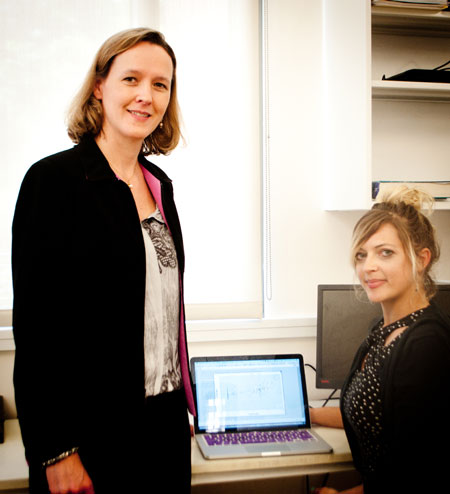Prenatal exposure to cadmium associated with increased risk of pre-eclampsia
October 6, 2015
Researchers from the University of North Carolina at Chapel Hill have demonstrated for the first time an association between levels of the toxic metal cadmium in the placenta during pregnancy and increased risk of the mother developing pre-eclampsia. The researchers also examined interactive effects of essential metals selenium and zinc with pre-eclampsia risk.
Formerly called toxemia, preeclampsia is a condition, usually developed in the second or third trimester of pregnancy, marked by high blood pressure and a high level of protein in the urine. Women with the condition often will have swelling in the feet, legs and hands.
The study, led by UNC Gillings School of Global Public Health’s Rebecca Fry, PhD, associate professor of environmental sciences and engineering, and first author Jessica Laine, doctoral student in epidemiology working in Fry’s lab, was published online Sept. 30 in the journal PLOS One.
Pregnant women can be exposed to cadmium through a variety of routes, including food sources (such as shellfish, liver and kidney meats, grain cereal products, potatoes and even some leafy vegetables) and cigarette smoke. In addition to pre-eclampsia, exposure to cadmium is associated with kidney disease, high blood pressure and cancer. Prenatal exposure to cadmium is associated with a variety of adverse health outcomes, including decreased newborn birth weight, length and head circumference, and impaired childhood neurobehavioral and physiological development.
This study measured placental cadmium, selenium and zinc levels in placental tissue using samples from a pregnancy cohort representing 172 women across the southeastern U.S. to examine associations of placental metal levels with the risk of pre-eclampsia. The study found concentrations of cadmium ranging from 0.52 ng/g up to 14.5 ng/g in placental tissue, consistent with observed levels in the U.S. and globally.
Researchers examined the role of essential metals selenium and zinc in reducing the odds of cadmium-associated pre-eclampsia. Selenium and zinc are both antioxidants, known to protect against cadmium-induced toxicity. Prior to this study, however, the relationship between cadmium, selenium and zinc levels in the placenta, as they relate to of risk of pre-eclampsia, was not known.
Data showed that elevated levels of cadmium in the placenta were associated with increased risk for pre-eclampsia, and that this risk increased with low selenium levels. This was in contrast to a lower risk when placental selenium levels were high. These data suggest that placental selenium protects against cadmium-associated pre-eclampsia. Zinc levels also were measured and support that zinc is protective against cadmium-induced toxicity during pregnancy.
“These data support a critical public health issue – namely, that prenatal exposure to toxic metals has the potential to harm pregnancies,” Fry said. “We continue to strive for increased exposure monitoring of environmental toxins during pregnancy.”
The findings highlight the potential impact of exposure to toxic metals such as cadmium on adverse pregnancy outcomes and the potentially important role that of essential metals in reducing the risk of pre-eclampsia associated with cadmium exposure.
Fry and colleagues note that biomonitoring of maternal exposure to metals potentially will help to reduce prenatal exposures to toxic metals and inform nutritional supplementation of essential metals, ultimately reducing future adverse pregnancy complications and birth outcomes.
In addition to Laine and Fry, co-authors of the study are Paul Ray, PhD, postdoctoral fellow in toxicology, Wanda Bodnar, PhD, research assistant professor, and Peter H. Cable, M.S., research specialist, all of the Gillings School’s Department of Environmental Sciences and Engineering; Kim Boggess, MD, professor of maternal and fetal medicine in the UNC School of Medicine’s obstetrics and gynecology department; and Steven Offenbacher, DDS, PhD, W.R. Kenan Jr. Distinguished Professor and chair of periodontology in the UNC School of Dentistry.

